How We Do It: A Classroom Journey with PODD by Rachael Langley
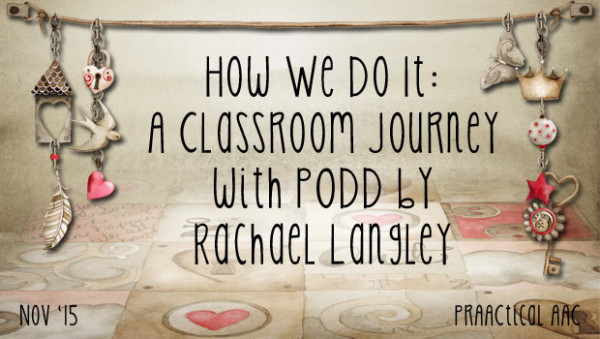
Let’s face it. Good AAC implementation takes commitment and requires a lot of effort from those who are with the AAC learners throughout the day. Sometimes an AAC tool or strategy that seemed pr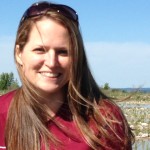 omising at first, doesn’t pan out to be as successful as expected. Other times, it’s a challenge to keep up with the demands of the classroom, therapy session, and life and still find the energy to consistently implement good AAC practices. In the real world, teams struggle with these issues every single day. So when Rachael Langley, a Michigan-based SLP and AAC specialist, offered to provide insight into what that process has been like in classrooms she supports, I was thrilled.
omising at first, doesn’t pan out to be as successful as expected. Other times, it’s a challenge to keep up with the demands of the classroom, therapy session, and life and still find the energy to consistently implement good AAC practices. In the real world, teams struggle with these issues every single day. So when Rachael Langley, a Michigan-based SLP and AAC specialist, offered to provide insight into what that process has been like in classrooms she supports, I was thrilled.
Rachael’s original post about using PODD in the classroom and her follow-up post on implementation tips gave us insight into the journey that one elementary school classroom team is taking to better serve their students with little or no functional speech. We heard from several of you who were inspired to learn more about the PODD approach and begin using it with AAC learners. As the AAC Specialist supporting this classroom team, Rachael works with teacher Jess Brown and SLP Sara Curtiss to help with planning and problem-solving. In this post, Rachael gives us an update on the team’s journey with this strategy.
::::::::::::::::::::::::::::::::::::::::::::::::::::::::::::::
About a year ago, I shared some ideas about how to make a PODD book portable, wearable, and comfortable. Today I revisit the classroom where I took those first pictures and share an update. Let’s start with my friend and coworker, who was kind enough to model for a few pictures last year. This is Jess Brown – a special education teacher who runs a busy classroom with 1st through 6th graders with complex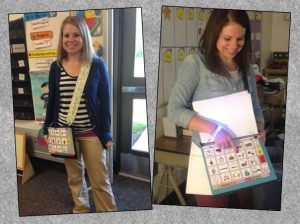 communication needs. The classroom is considered a self-contained program for students with mild cognitive impairments. Their classroom is part of a large elementary school and students have opportunities to participate with their general education peers throughout their school day. What this means for Jess is that her classroom has approximately 9-12 students and several paraprofessionals to support the students in general education and for individualized support within her room. The classroom has a mixture of students with ASD, Down Syndrome, cerebral palsy, and other physical & neurological differences. A few of the students have some verbal output, but for the most part, Jess’ students are functionally non-verbal. A couple of her students have personal AAC, which they continued to use in conjunction with PODD as a universal support.
communication needs. The classroom is considered a self-contained program for students with mild cognitive impairments. Their classroom is part of a large elementary school and students have opportunities to participate with their general education peers throughout their school day. What this means for Jess is that her classroom has approximately 9-12 students and several paraprofessionals to support the students in general education and for individualized support within her room. The classroom has a mixture of students with ASD, Down Syndrome, cerebral palsy, and other physical & neurological differences. A few of the students have some verbal output, but for the most part, Jess’ students are functionally non-verbal. A couple of her students have personal AAC, which they continued to use in conjunction with PODD as a universal support.
At the time those first pictures were taken, Jess and one of the classroom paraprofessionals had been to a one-day PODD overview session. They understood the basic premise of the PODD, but the implementation was still a bit daunting. We started with getting several books in the room and making them portable and comfortable. As you can tell from this first picture, Jess is wearing a PODD 12 (with 12 icons per page) and a cheerful smile. In December of last year, Jess and two of her paraprofessionals went to a two-day PODD training. They quickly went from tolerating the PODD 12 to requesting that we purchase or create some PODD 40 and PODD 70 books. They ditched the PODD 12 and used PODD 20 as the one-page opening book for whole-group modeling. Many of their 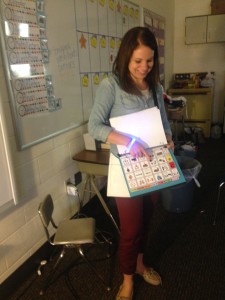 students, who had tried various types of communication support over the years (with varying degrees of success) were now tuning in to the PODD. Students were attending to staff modeling and initiating comments using PODD. Students were connecting. Behaviors were decreasing, because staff could come along side students and say, “I have something to say. It looks like something’s wrong. You look upset.” Just labeling this behavior through the PODD was enough to de-escalate some frustrated kiddos and give them an opportunity to engage with a staff member through PODD.
students, who had tried various types of communication support over the years (with varying degrees of success) were now tuning in to the PODD. Students were attending to staff modeling and initiating comments using PODD. Students were connecting. Behaviors were decreasing, because staff could come along side students and say, “I have something to say. It looks like something’s wrong. You look upset.” Just labeling this behavior through the PODD was enough to de-escalate some frustrated kiddos and give them an opportunity to engage with a staff member through PODD.
Fast forward to Fall 2015 and we, as an AAC team, are regularly talking about students in Jess’ classroom. Are we modeling the best level of PODD to meet their language needs? Who needs a draft book customized for personal use? Whose family needs to be invited to a PODD training to see how this tool works with their child? While there is always more learning and training to be done, this classroom has done an exceptional job at making aided language available and teaching PODD through language immersion. I asked Jess if she would answer a few questions regarding PODD and the past year of implementation.
Rachael: What was the most helpful thing that made PODD ‘take hold’ in your classroom?
Jess: Honestly, I didn’t really believe PODD could work in the classroom until I attended the training and saw the videos of PODD being used by actual students. It was amazing to see students that wouldn’t have a voice be able to do more than make a request. This was the beginning but the most helpful was attending the two-day training with some of my aides. This way it wasn’t just me trying to push PODD. I needed other adults in the classroom to be on board and that wouldn’t have happened without them fully understanding PODD and believing that it can work.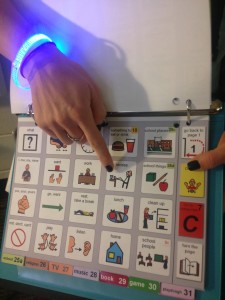
Rachael: You started with a PODD 12, and now use PODD 20, 40, & 70 in your classroom. How is a two-page opening book (40 or 70) easier or better than 12?
Jess: The more symbols you have the more you can say. It is so much easier to teach a lesson with a bigger vocabulary. Imagine trying to have a conversation with limited words plus it takes so much more time to flip and have to go back to the categories page in the 12. I love how I can teach a whole lesson and communicate with a PODD when I am using the 70.
Rachael: Do you have doubters come into your room? How do you respond when people say “Your students can’t handle 70 icons at a time.”
Jess: I honestly haven’t had a lot of doubters. I had one person say that the 40 had too many pictures for a student with ASD to focus on. I sho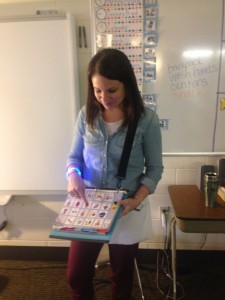 wed that person how a PODD works and told them that more symbols meant more opportunities to communicate. I also always tell doubters or people that are unsure to watch videos online of PODD being used.
wed that person how a PODD works and told them that more symbols meant more opportunities to communicate. I also always tell doubters or people that are unsure to watch videos online of PODD being used.
Rachael: What’s the biggest success you’ve seen with PODD? Is there a particular moment or a particular student that stands out?
Jess: There have been a lot of moments! I don’t know if I can pick one…”L” who was unresponsive and didn’t make requests now states “I have something to say” and can find the pictures for break, hungry and thirsty and music in multiple locations. “B” today got up and went and found glue because Tricia (aide) was communicating instruction with the PODD.“E” has only used the PODD since starting here (six weeks ago) and is already requesting breaks, walk, recess and lunch. She also identifies colors in the PODD and completes activities using the PODD.
Rachael: What is the biggest challenge with continuing to use PODD as a universal support in your classroom?
Jess: The biggest challenge for me right now is trying to find the best PODD to always have with me. I like using the 2 page opening books but they aren’t always as accessible. The PODD to me is the easiest aided communication to use in the  classroom. Much easier than pictures around the room or PECS. So now you just have to find a way to give me a two page opener that is able to be carried hands free. 🙂
classroom. Much easier than pictures around the room or PECS. So now you just have to find a way to give me a two page opener that is able to be carried hands free. 🙂
Thanks to Jess Brown, Sara Curtis (the awesome SLP for this classroom), and the fantastic classroom staff for supporting our students in a meaningful way! You’re creating a great aided language environment where multi-modal language is used and students are growing their communication skills every day.
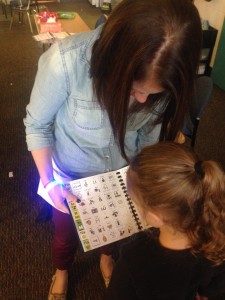
Filed under: PrAACtical Thinking
Tagged With: classroom, PODD, Rachael Langley
This post was written by Carole Zangari

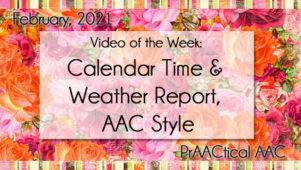
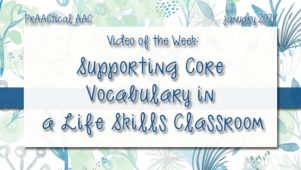
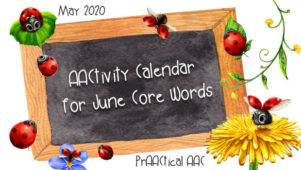

5 Comments
Way to go, Rachael and Jess!! By the way, is that a glow bracelet being used to get students to attended to book? Genius!
Carol, I was talking with you last night on Facebook! I do have one questions. I am a Special Ed Teacher for 6th and 7th grade. My Speech Path and I are starting this program with one of my students. He is somewhat familiar with symbols and what they mean. We have started some story lines with pictures, but what do you recommended we do in the classroom to start the PODD process? Basically where to start? My speech person is only thru a computer and lives about 5 hours away so I am kinda on my own as in prep and getting the process started. Any ideas would be appreciated.
Thanks
Tracy Wolgamott
Kansas
Hi Tracy!
I’m not Carole, but I’ll give my 2 cents here. First step with PODD is you get a book and model, model, model. Pair the symbols in the PODD book with the words you are already saying. Don’t get stuck on word-for-word modeling, since most of the time you’ll point to the concept and drop the small words. For example, “It looks like you’re all done,” I might just point to “you” and “done/finished.” But I still say my whole phrase.
The modeling never ends, as it takes time for us to become familiar with PODD organization, and often longer for our students to use the PODD expressively. All the PODD trainers I’ve heard suggest that you make small videos throughout the learning process. Especially if your SLP is remote! Videos capture progress and allow us to see how our modeling really looks.
Kudos to you for starting a rich language program to better support your students!! Keep up the great work!
Rachael
Tracy, Rachael gave some great suggestions. For the first few weeks or months, focus on yourself and the other classroom staff with the goal of using PODD as frequently as possible whenever you speak to the student. That establishes a good language learning platform for the student who will be using PODD and will be the foundation for specific skill development. Just like typically developing babies are reared in an environment where they are hearing English all day, every day before they are expected to produce speech, your students will need to see a TON of PODD use before they can reasonably be expected to utilize it themselves. Hope that makes sense. The more often you and your staff use the PODD, the better. 🙂
omg so useful article.